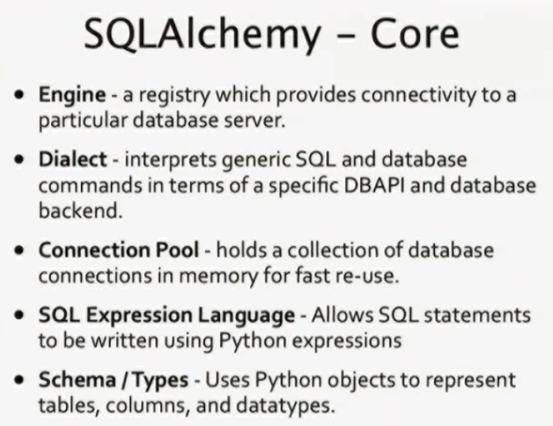SQLAlchemy is some sort of powerful SQL toolkit and Object-Relational Umschlüsselung (ORM) library with regard to Python that allows for database software and businesses. It abstracts away much of the complexity regarding getting together with relational databases, making it simpler for developers to focus on business common sense instead of SQL questions. Whether you’re a beginner or a seasoned developer, having a set associated with handy SQLAlchemy snippets could make managing your own database operations extra efficient. Here are 12 useful SQLAlchemy thoughts for everyday databases management, covering a range of common tasks.
1. Connecting to Get the facts
Before you may interact with a new database using SQLAlchemy, you need in order to establish a network. This snippet assists you to set up some sort of connection to a repository, which can always be any SQL-compatible database like SQLite, PostgreSQL, or MySQL.
python
Copy code
by sqlalchemy import create_engine
# Replace with your database WEB ADDRESS
DATABASE_URL = „sqlite: ///example. db“
# Create a data source engine
engine = create_engine(DATABASE_URL)
# Set up a connection
connection = engine. connect()
print(„Database connected successfully. „)
This snippet makes an engine of which serves as the key interface to the database. Using create_engine(), you can hook up to various databases utilizing the appropriate connection string.
2. Defining a Model
In SQLAlchemy, versions represent tables in the database. This little shows how to be able to define a basic table model with columns and types.
python
Copy code
from sqlalchemy transfer Column, Integer, Chain
from sqlalchemy. ext. declarative import declarative_base
Base = declarative_base()
class User(Base):
__tablename__ = ‚users‘
identity = Column(Integer, primary_key=True)
name = Column(String)
email = Column(String, unique=True)
def __repr__(self):
return f“
The person class represents an consumers table with three columns: id, name, and email. Applying declarative_base() lets you specify models in a object-oriented way.
3. Developing Tables
Once your models are identified, you can make tables in typically the database using this particular snippet:
python
Copy code
# Make all desks
Base. metadata. create_all(engine)
print(„Tables created successfully. „)
This will create the users table (or any other models you have defined) in your repository based on the particular structure in the type classes. It’s valuable when preparing the particular initial database schema.
4. Adding Information to the Databases
Inserting data directly into your tables is usually a common activity. This snippet shows how to add brand new records towards the consumers table:
python
Duplicate code
from sqlalchemy. orm import sessionmaker
Session = sessionmaker(bind=engine)
session = Session()
new_user = User(name=’John Doe‘, email=’john@example. com‘)
session. add(new_user)
program. commit()
print(„New end user added. „)
Right here, the session is used to add a new User object to the users table. session. commit() saves the in order to the database.
a few. Querying Data
To be able to retrieve data from the database, you can use queries. This snippet demonstrates how to fetch just about all users from the users table:
python
Copy code
# Fetch all consumers
users = period. query(User). all()
intended for user in consumers:
print(user)
Using session. query() allows you to interact together with the database inside an object-oriented method. This snippet retrieves all user documents and prints these people.
6. Filtering Data
Often, you need to filtration data according to particular conditions. This minor amount shows how you can filtering users by name:
python
Copy signal
# Fetch a good user by name
user = program. query(User). filter_by(name=’John Doe‘). first()
print(user)
This specific will return the very first user record which fits the name ‚John Doe‘. filter_by() is a convenient approach for filtering data based on line values.
7. Changing Documents
Updating records is a frequent operation if managing databases. This specific snippet shows how to update the user’s email:
python
Copy code
# Update an user’s email
user = session. query(User). filter_by(name=’John Doe‘). first()
customer. email = ‚john. doe@example. com‘
program. commit()
print(„User email updated. „)
After fetching the consumer document, you can modify its attributes and call session. commit() to save lots of the changes.
eight. Deleting Records
To be able to delete records coming from a table, use the following minor amount:
python
Copy computer code
# Delete the user
user_to_delete = session. query(User). filter_by(name=’John Doe‘). first()
treatment. delete(user_to_delete)
session. commit()
print(„User deleted. „)
This snippet brings an user simply by name and and then deletes the document using session. delete(). Be sure you commit the particular changes to make the removal permanent.
9. Applying Raw SQL together with SQLAlchemy
While SQLAlchemy’s ORM is powerful, sometimes you need to perform raw SQL concerns directly. This small shows how you can implement a raw SQL query:
python
Duplicate code
# Execute a raw SQL problem
result = engine. execute(„SELECT * FROM users“)
for line in result:
print(row)
Using engine. execute(), you can run raw SQL concerns for complex functions or tasks not necessarily easily achieved along with the ORM.
twelve. Handling Dealings
Transactions are useful with regard to ensuring data ethics during multiple databases operations. This small demonstrates how to use transactions in SQLAlchemy:
python
Backup code
from sqlalchemy. exc import SQLAlchemyError
try:
with treatment. begin():
new_user = User(name=’Jane Doe‘, email=’jane@example. com‘)
session. add(new_user)
another_user = User(name=’Alice Smith‘, email=’alice@example. com‘)
session. add(another_user)
print(„Transaction successful. „)
apart from SQLAlchemyError as elizabeth:
session. rollback()
print(f“Transaction failed: e „)
The session. begin() context helps to ensure that just about all operations inside the prevent are executed while a single purchase. If any mistake occurs, the adjustments are rolled back again to maintain uniformity.
Conclusion
These ten SQLAlchemy snippets will simplify everyday database management tasks, regardless of whether you’re working on a little project or owning a larger data source system. From linking into a database in addition to defining models to be able to executing complex inquiries and handling purchases, these snippets offer a firm base for bonding with databases employing SQLAlchemy. Using these tools in hand, you could efficiently manage your own database operations, ensuring that your data remains organized and available. Happy coding!